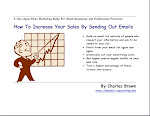Just like a road trip, a website n must have a specific destination in mind before you start out. When visitors arrives at your site, if you have not painted them a “yellow brink road” to lead them to where you want them to go, they are apt to go just anywhere.
If your website is for business, there are only four possible destinations. Each and every word of content must be written with any or all of these destinations in mind. Your goal must be to lead every qualified visitor to take one of these actions:
- To get the visitor to buy right now. If you are selling merchandise, you should have very clear offers, order forms and promises that lead your visitors to pull out their credit cards right now.
- To get visitors to contact your company to do business or to find out more with doing business in mind. Have your contact information visible on every page (an all too often violated rule) and give visitors REASONS to contact you. What I usually see is content so lacking in tangible benefits, the visitor only thinks, “I’m glad I know about these guys now, if I ever need them, now I know where they are.”
- To get visitors to leave their contact information. This is the heart and soul of permission marketing. Offer visitors something of value like free information, as an ethical bribe to get them to provide their names and email addresses. This destination is to generate leads that you can follow up with future contacts.
- To get visitors to come back to your site. This destination leads them to bookmark your site or subscribe to your feed so they are updated whenever you post new material.
None of this is easy, but if you set up a website aimlessly without purpose, these goals are impossible. As I said before, once you know where you want to lead visitors, write every word of content toward leading them to take these actions.
What are your ideas on this? I’d love to hear any of your examples and insights into this.
freelance copywriter, ghost writer, web content writer, white papers
COPYRIGHT © 2006, Charles Brown

Subscribe to:
Post Comments (Atom)



I think you are on the money. When a marketer offers something free to a potential client, the guilt sets in and the client will have to act. A great example of this is the free flower given by the Hare Krishnas.
Griffin said...
3:16 AM
You are right but there is also a lot more to it. It is called the "Law of Reciprocity." But I think it also creates a bond between the marketer who gives freely and the prospective customer.
Charles Brown
Charles Brown said...
8:45 PM
You've got me thinking about my website.
I offer a free e-publication to folks who sign up for my e-newsletter. But that's just on one page of my site.
I'm going to look at your site to see how you make your free offer.
Susan Weiner, CFA said...
8:35 AM
Susan,
You might want to see what would happen if you made the benefits of your newsletter one of the primary focal points of your website.
My free offer is my ebook, 99 Secrets to Irresistible Electronic Copywriting. I am constantly changing it and improving it, but I benefit far more by giving it away for free than if I sold it.
Charles Brown
Charles Brown said...
10:29 AM